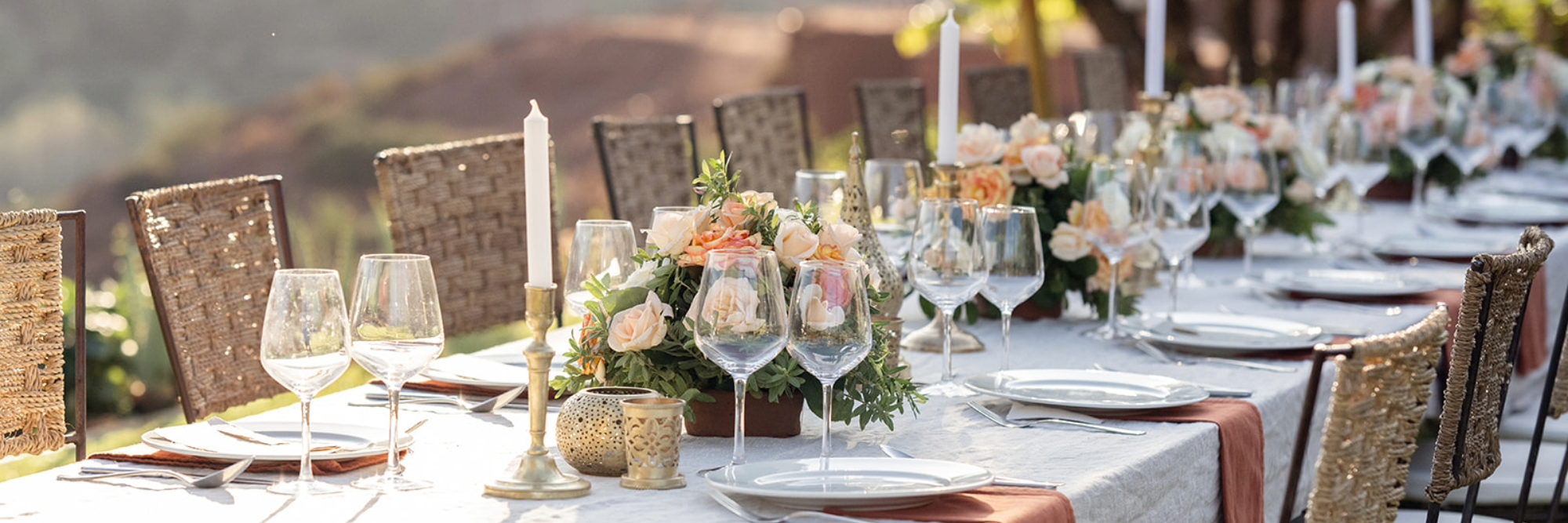
Experience a culinary journey at your Moroccan wedding reception, where the rich flavors of Arab, Berber, and Jewish traditions come together to create unforgettable memories. From elegant plated dinners starting at just 50 euros per person to sumptuous buffet spreads designed to please every palate, our Moroccan wedding food menu options cater to all tastes.
We’ve curated 10 must-try dishes that will take your guests straight to the heart of Morocco’s celebrated food culture. The iconic lamb tagine and the sweet-and-savory pastilla stand out as wedding favorites, showcasing the best of traditional Moroccan cuisine.
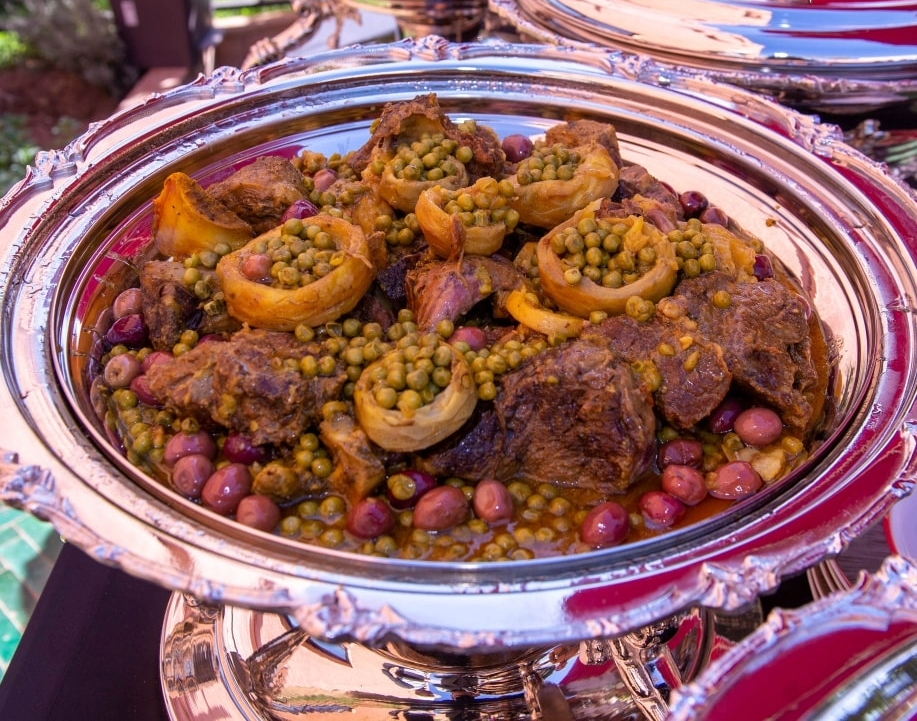
Crédit photo Afrah Darna
Traditional Moroccan Wedding Mint Tea Ceremony
The mint tea ceremony stands as one of the most cherished moments in a Moroccan marriage. This beautiful ritual made its way to Morocco in 1854 during the Crimean War and became the life-blood of Moroccan wedding customs and hospitality.
The pouring technique requires real skill. Hosts pour the tea from a height to properly oxygenate it and release its full aroma.
The tea ceremony features an array of traditional Moroccan appetizers. These must-have elements include:
- Kaab el Ghzal (gazelle horns) – crescent-shaped cookies with almond paste and orange blossom water
- Fekkas – Morocco’s beloved biscotti with toasted almonds and anise
- Ghriba – crumbly cookies made with flour, sugar, butter, and almonds
Hosts serve this whole ordeal on beautiful artisanal trays made of silver or copper. These trays create an elegant, traditional atmosphere that sets the perfect tone for the Moroccan feast ahead.
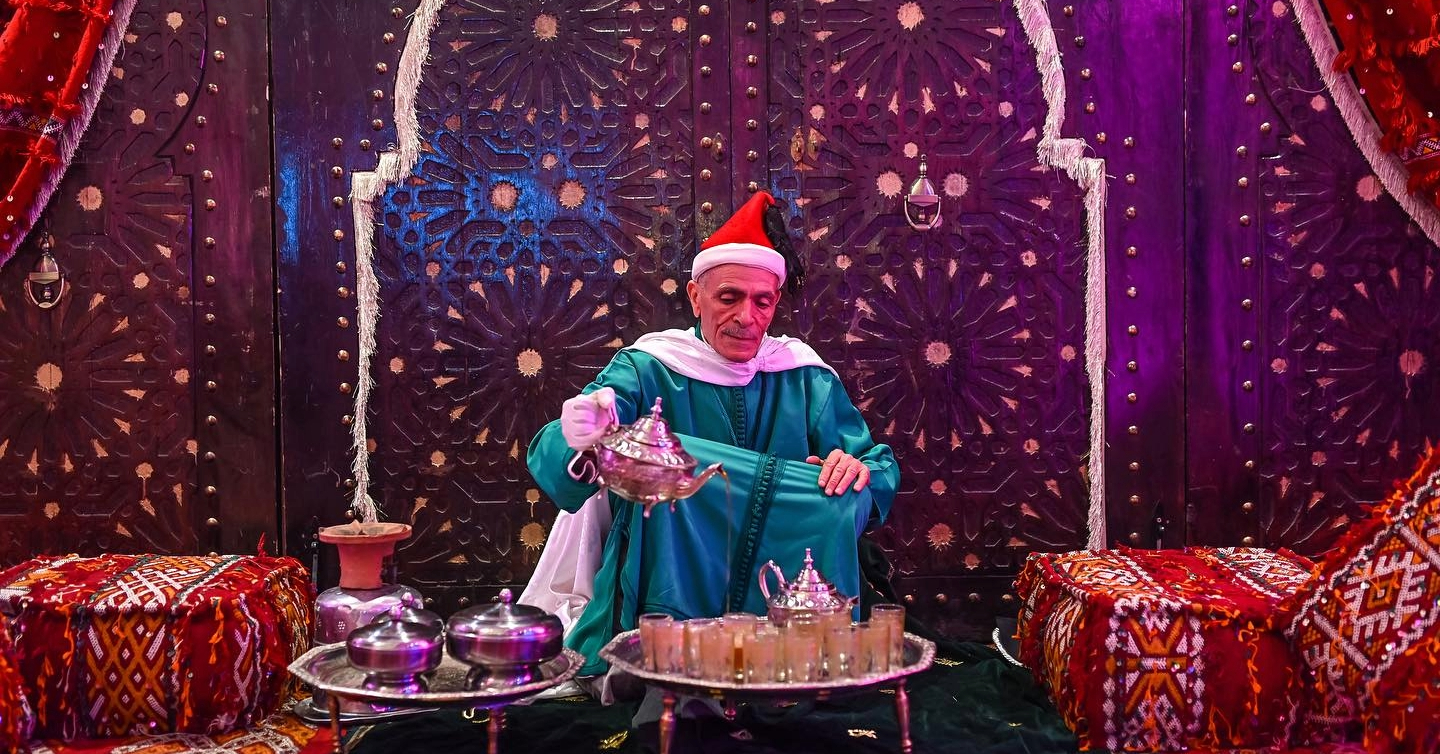
Crédit photo Studio Majorel
Moroccan Wedding Pastilla
Let’s talk about the crown jewel of Moroccan wedding dishes – the magnificent pastilla. This exquisite dish from Fez shows evidence of Morocco’s rich culinary heritage and is a staple in any Moroccan dinner party menu.
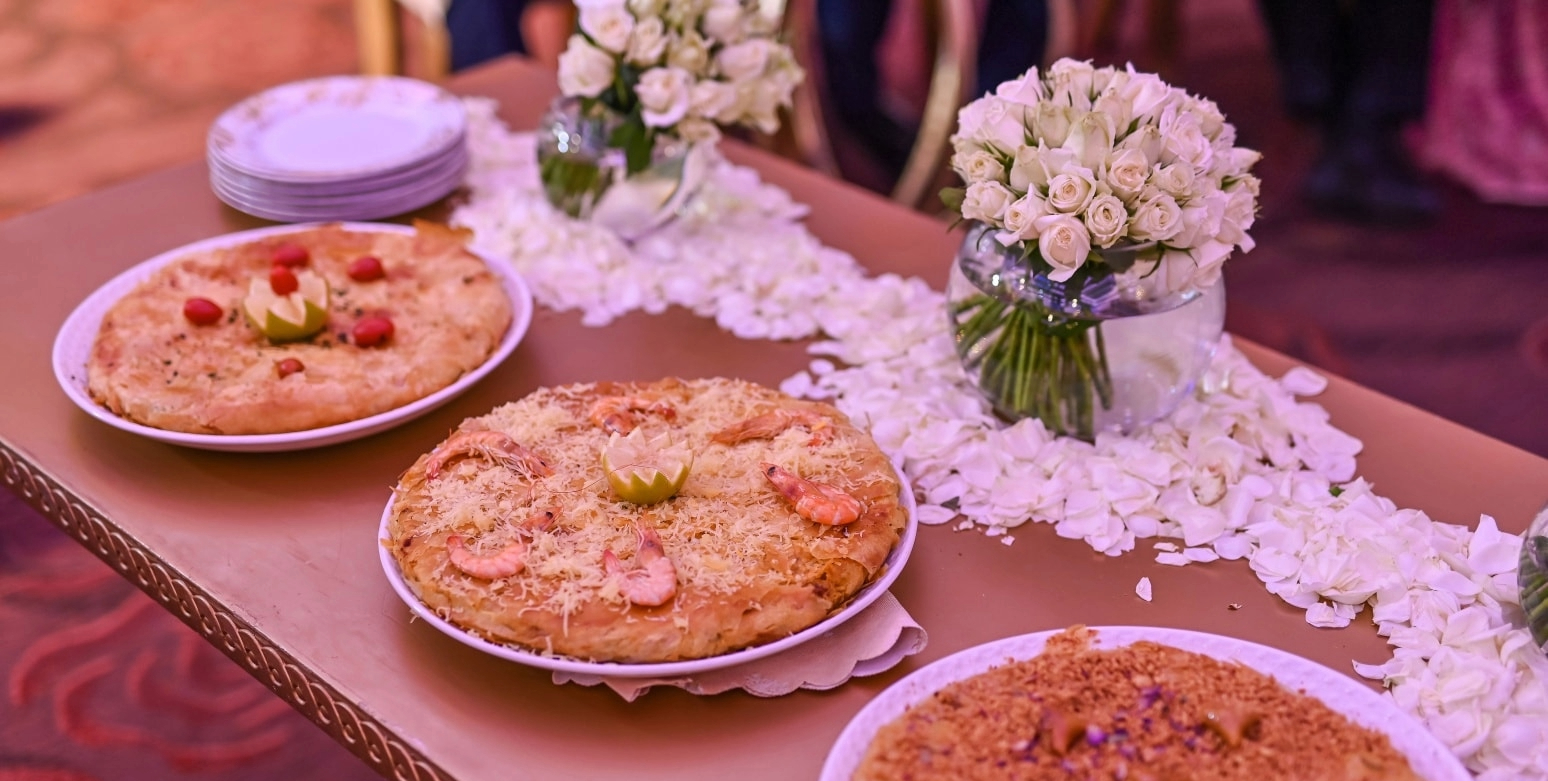
Crédit photo afrah Darna
Traditional Pastilla Preparation
The magic starts with buttered phyllo sheets carefully layered to create a crispy exterior. The filling combines tender shredded meat (traditionally pigeon or chicken) with aromatic Moroccan spices, eggs, and almonds. The sort of thing I love about this dish is its final touch – a delicate dusting of powdered sugar and cinnamon creates an unforgettable sweet-savory balance.
Wedding Pastilla Presentation
Moroccan weddings serve pastilla as the first course around midnight. This timing makes perfect sense since celebrations continue until dawn, and guests need sustaining nourishment. The dish comes in two main varieties:
- Traditional chicken pastilla with almonds and aromatic spices
- Coastal-inspired seafood pastilla with vermicelli and chermoula
Regional Pastilla Variations
Morocco’s regions offer fascinating takes on this wedding staple. Fez, the birthplace of Moroccan gastronomy, prepares it with slow-cooked pigeons. Casablanca’s coastal influence shines through their seafood version, while Chefchaouen adds an Andalusian touch with extra sweetness. Each region’s unique approach shows this dish’s importance in Moroccan wedding traditions.
Lamb Tagine with Prunes
The star of Moroccan wedding feasts is the amazing lamb tagine with prunes. This dish creates magic by bringing tender lamb and sweet dried fruits together in perfect harmony, exemplifying the essence of Moroccan flavors.
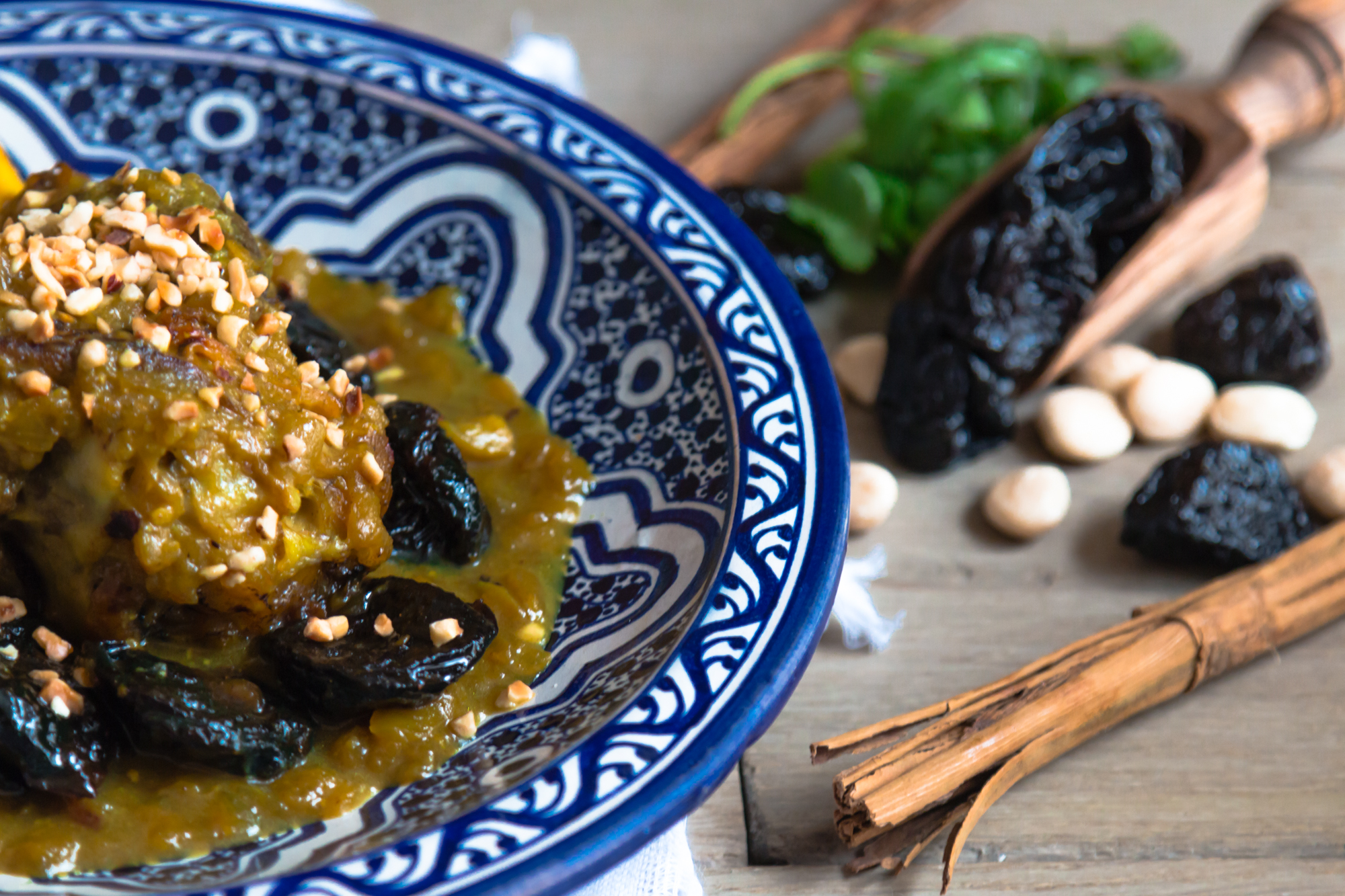
Crédit photo https://www.mymoroccanfood.com/
Traditional Wedding Tagine Recipe
The process begins with lamb marinated in exotic Moroccan spices, then grilled to perfection in olive oil and butter. Here are the key ingredients needed:
- Ground coriander, cinnamon, and cumin
- Saffron threads soaked in water
- Orange blossom water for authentic aroma
Symbolic Meaning in Wedding Feasts
This dish plays a special role in Moroccan wedding celebrations. Many families put their heart and soul into its preparation. The mix of meat and dried fruit has been the life-blood of Moroccan cooking since medieval times, with roots in Andalusian culinary traditions.
Serving Traditions
The serving style brings a unique touch as guests gather around a shared plate. Everyone’s eyes light up when the tagine arrives with caramelized prunes and a sprinkle of toasted sesame seeds or roasted almonds. Notwithstanding that, the dish’s true magic lies in how it brings people together, as they use traditional Moroccan bread to scoop up the tasty meat and sauce.
Wedding Couscous with Seven Vegetables
Traditional Moroccan wedding feasts feature the beloved couscous with seven vegetables, a dish that brings families together in celebration and showcases the diversity of Moroccan flavors.
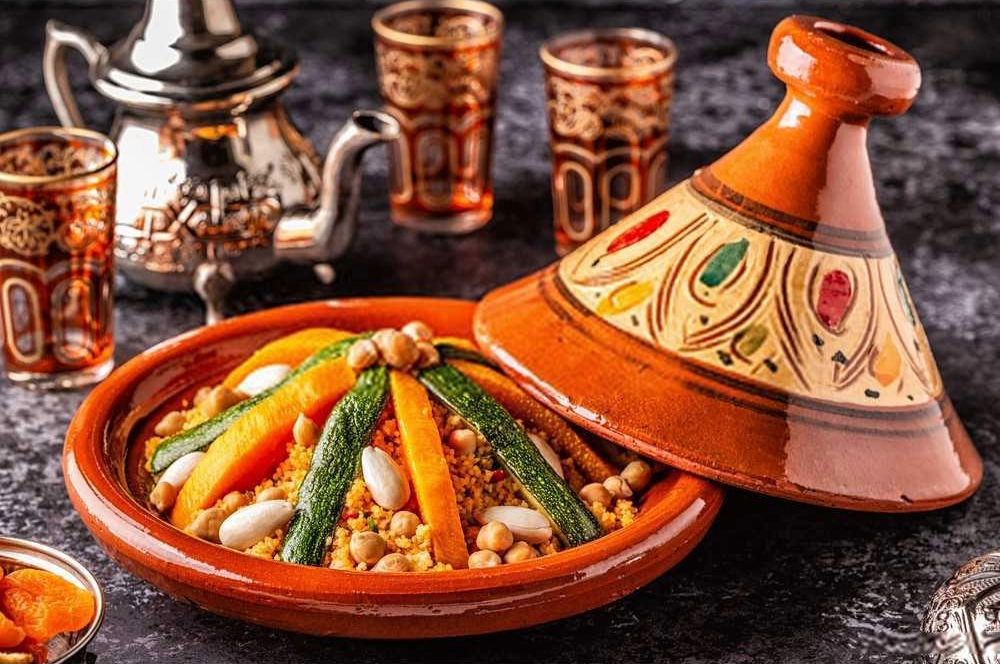
Significance of Seven Vegetables
This dish holds a special place in our hearts, not just for its flavors but for its deeper cultural meaning. Seven represents abundance and good fortune in Moroccan traditions. The symbolic dish appears at weddings to bless the couple’s new life with prosperity.
Traditional Preparation Method
A specialized two-part cooking vessel called the couscoussier makes this dish possible. The couscous needs three rounds of steaming over aromatic broth. Light toasting comes first, and a 30-minute steam follows. Cold water, salt, and olive oil prevent the grains from clumping together.
The classic combination has:
- Carrots, pumpkin, and turnips
- Zucchini and cabbage
- Chickpeas and onions
Wedding Presentation Style
This dish becomes a stunning centerpiece during the presentation. A large, shallow mound of couscous sits on a communal platter. Each vegetable finds its place in a well at the center, showcasing its colors and textures beautifully. Fragrant broth drizzled over the dish brings all flavors together perfectly.
Moroccan Wedding Seafood Pastilla
The scenic Moroccan coastline has given birth to a delightful twist on traditional wedding feasts – the seafood bastilla. This coastal-inspired dish has gained popularity at special occasions and wedding celebrations over the past few decades.
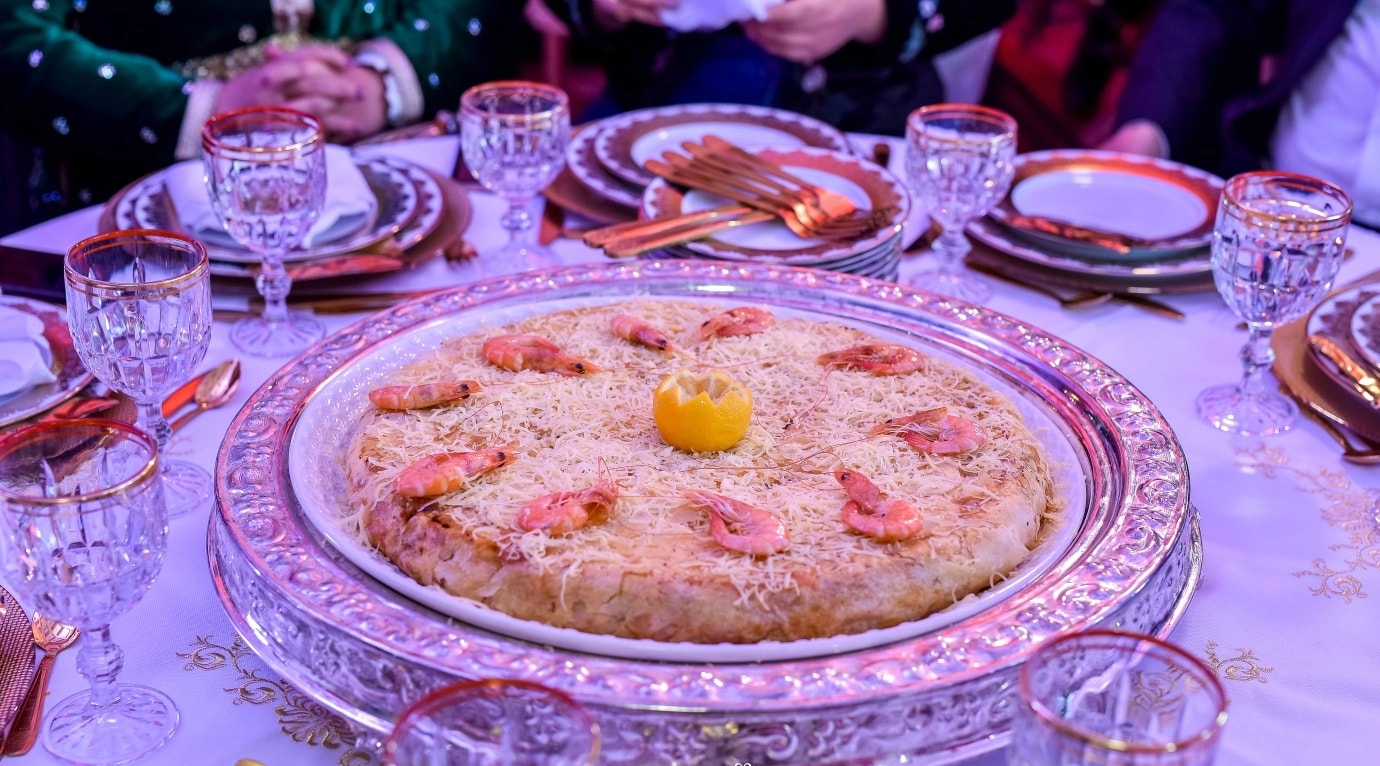
Crédit photo Afrah Darna
Coastal Wedding Traditions
This luxurious variation of classic bastilla comes from our coastal regions. Seaside cities have embraced it as a cherished part of their wedding menus. The dish beautifully represents Morocco’s maritime heritage through a delicate combination of white fish, saffron, and preserved lemons.
Seafood Bastilla Preparation
The impressive dish combines these essential ingredients:
- Fresh seafood (shrimp, calamari, and white fish)
- Chinese vermicelli
- Zesty chermoula marinade
- Phyllo dough
Home cooks can master this recipe despite its time-consuming nature.
Serving Customs
Wedding celebrations showcase these bastillas on large platters adorned with:
- Fresh parsley and lemon slices
- Crisp lettuce leaves
- Decorative shrimp arrangements
The versatile bastilla comes in various sizes. Smaller portions work perfectly as Moroccan wedding appetizers, while grand versions can feed up to ten guests. The golden-brown, crispy exterior creates a stunning centerpiece that captivates guests’ attention at wedding feasts.
Moroccan Wedding Lamb Mechoui
Without doubt, mechoui stands as the most iconic dish at traditional Moroccan wedding feasts – a masterpiece of slow-roasted lamb that represents our culinary heritage and is a highlight of any Moroccan food menu.
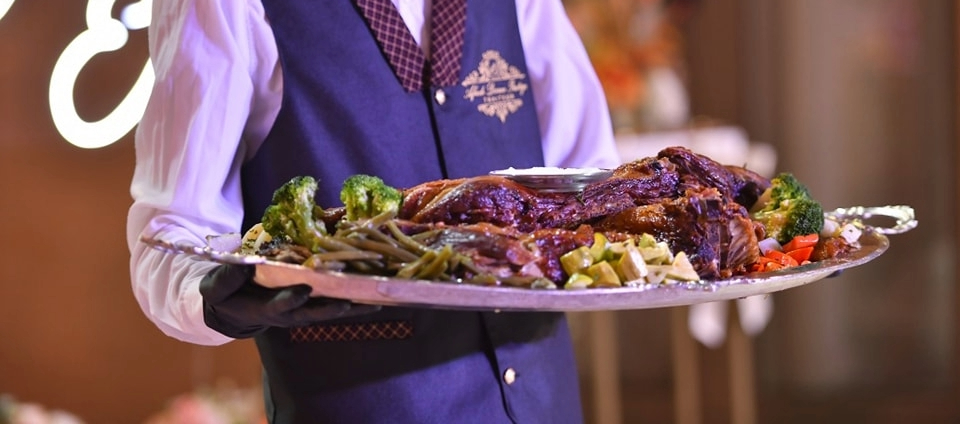
Crédit photo Afrah Darna
Traditional Cooking Process
Our distinctive clay ovens called ferran or underground pits serve as the perfect vessel to prepare this celebratory dish. The lamb needs marination with:
- Cumin and paprika
- Fresh garlic cloves
- Traditional smen (aged butter)
The meat then undergoes a slow roasting process that typically lasts 5-6 hours. This technique lets the fat melt slowly and creates meat tender enough to eat by hand.
Cultural Significance
Mechoui means much more than just a meal at our wedding celebrations, similar to its careful preparation process. The dish symbolizes abundance and our tradition of Moroccan hospitality. Grand weddings sometimes feature a whole sheep prepared mechoui style at each table.
Serving Rituals
Mechoui comes to the table with traditional accompaniments:
- Moroccan flatbread
- Bowls of cumin and salt for seasoning
- Fresh mint tea that balances the rich flavors
The host begins serving by taking pieces of meat with their right hand and sharing them with guests. This simple act captures the warmth and hospitality that define our wedding celebrations.
Traditional Wedding Briouats
The magic of Moroccan weddings comes alive with briouats – small, flaky pastries that light up every celebration. These little treats show our skill at blending sweet and savory flavors into perfect bite-sized delights and are essential Moroccan starters.
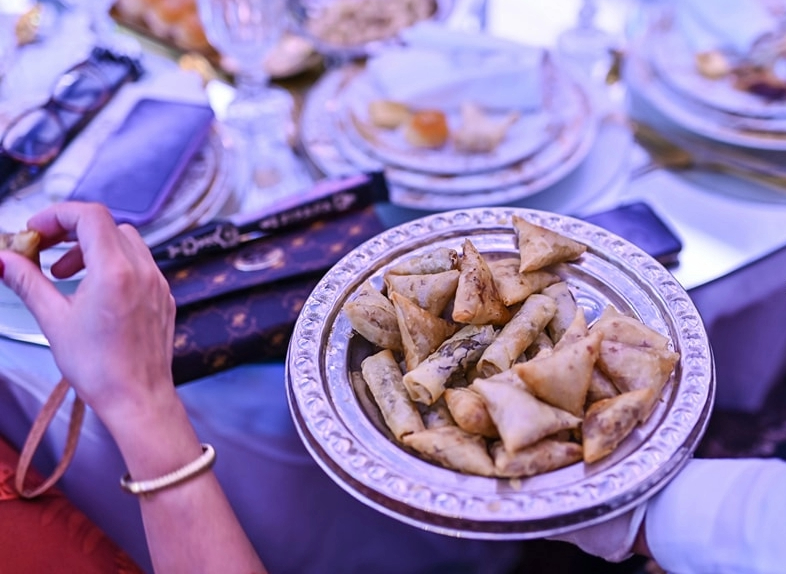
Crédit photo Afrah Darna
Sweet vs Savory Variations
We make two main types of wedding briouats:
- Sweet ones filled with almond paste, cinnamon, and orange blossom water
- Savory ones packed with spiced ground meat, seafood, or vegetables
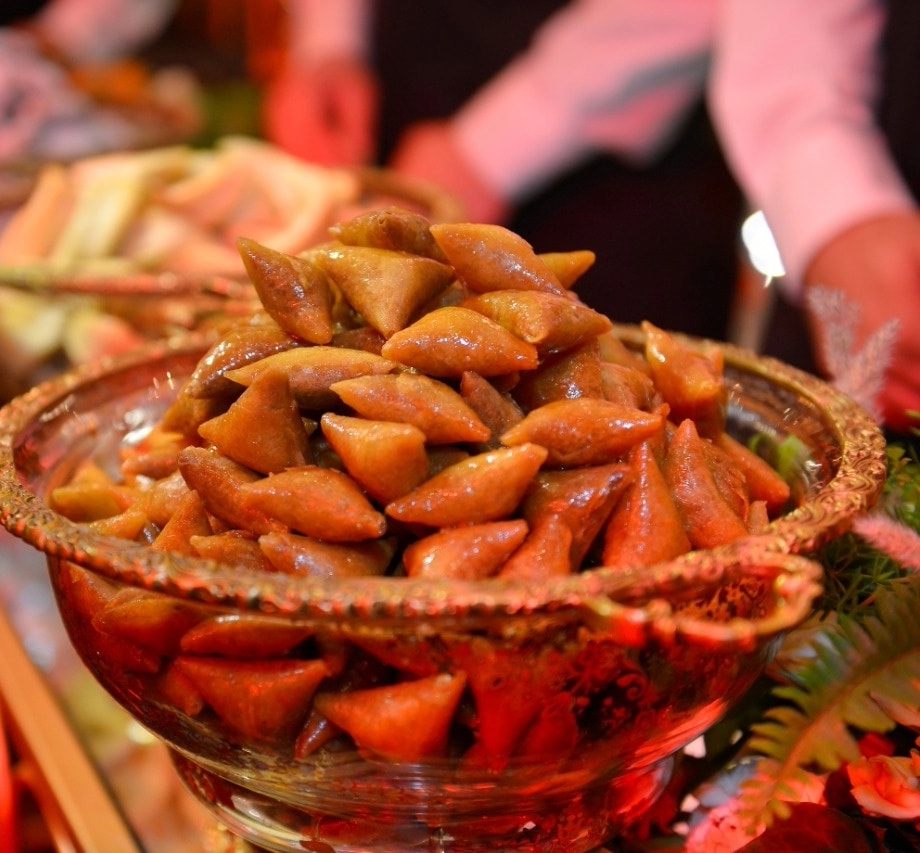
Crédit photo Afrah Darna
Wedding Preparation Methods
The secret starts with picking the best phyllo dough and creating just the right filling. The real art lies in the folding – a precious skill that families pass down through generations.
Presentation Styles
Our wedding feasts feature briouats in two special ways. Sweet ones sparkle with powdered sugar and sometimes a touch of honey. The savory ones come on beautiful platters next to fresh mint tea. These treats mean so much to our wedding traditions that guests enjoy them throughout the celebration, from the first tea ceremony to midnight.
We shape them into triangles and cylinders, and the special ones we call « honey cigars » during celebrations. These golden-brown treasures create a beautiful sight that captures the heart of Moroccan wedding hospitality.
Moroccan Wedding Fruit Display
The grand feast at our traditional Moroccan wedding celebrations reaches its peak with a breathtaking fruit display. This colorful arrangement ended up becoming both a decorative masterpiece and a delightful dessert that fills the atmosphere with abundance and joy.
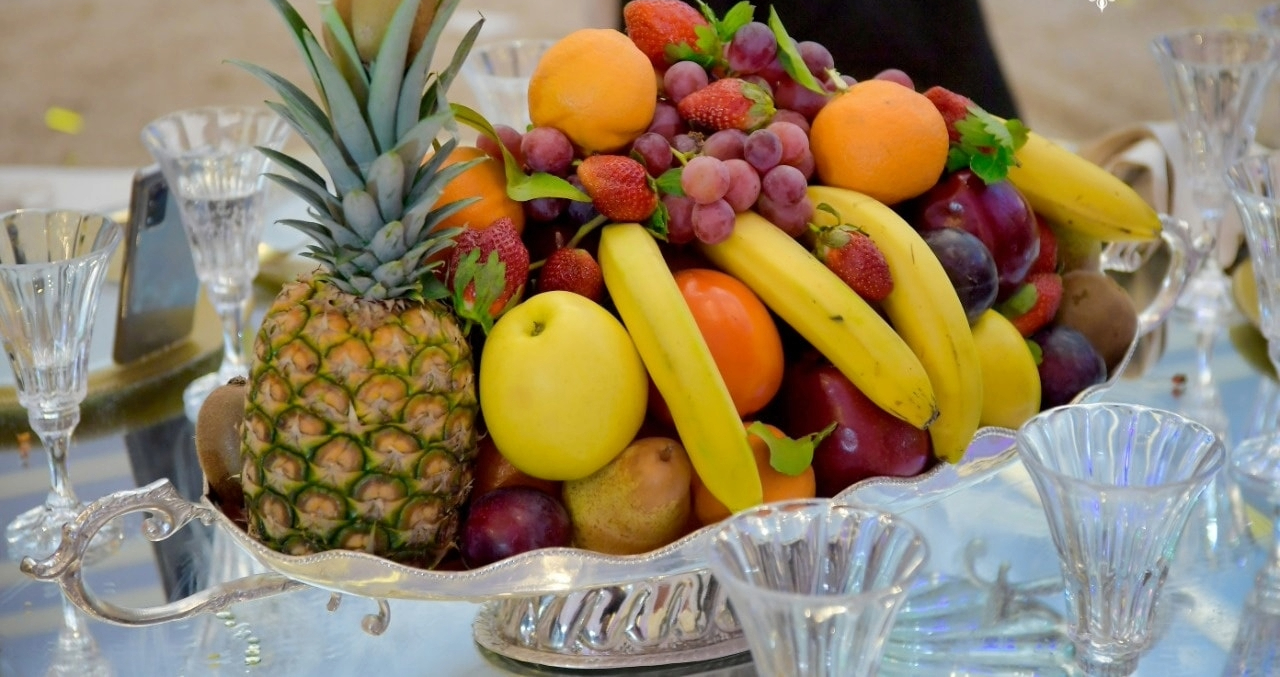
Seasonal Fruit Selection
We carefully pick the finest seasonal fruits. Our traditional selection includes:
- Fresh dates and almonds – symbolizing sweetness in life
- Pomegranates and oranges – representing fertility
- Apples and persimmons – adding vibrant colors
- Walnuts, pistachios, and pine nuts – offering texture and variety
Traditional Arrangement
The presentation showcases true artistry. Beautiful brass or copper circular platters become the canvas for our layered creation of colors and textures.
Symbolic Meanings
Our fruit display’s elements carry deep meaning. Dates paired with almonds mirror the perfect union of newlyweds. These ingredients hold a sacred place in Islamic culture, particularly dates. The abundant fruit spread represents hopes for a marriage filled with prosperity.
Sweet treats complete this midnight feast as the fruit display sits among delicious Moroccan cookies. Morocco’s position as the world’s fifth-largest almond producer makes these nuts a source of pride at our wedding celebrations.
Traditional Wedding Cookies (Kaab el Ghazal)
Kaab el Ghazal (Gazelle Horns) cookies make every Moroccan wedding celebration special. These crescent-shaped delicacies have been part of our festive tables through generations. Their presence adds deep cultural significance to our wedding traditions and are a must-have in any Moroccan desserts dinner party.
Cookie Varieties
Our families prepare several versions of these beloved treats. The most treasured recipe features delicate pastry dough with almond paste and orange blossom water. Different regions add their special touches to the recipe. Some bakers mix cinnamon and anise to add warmth, while others decorate with sesame seeds or brush with honey glaze for extra sweetness.
Traditional Recipe
Our family’s recipe has passed through generations with precise measurements. We combine ground almonds with powdered sugar, butter, and orange blossom water to create the perfect filling. The pastry needs gentle handling to achieve its signature thin texture that wraps the aromatic filling beautifully.
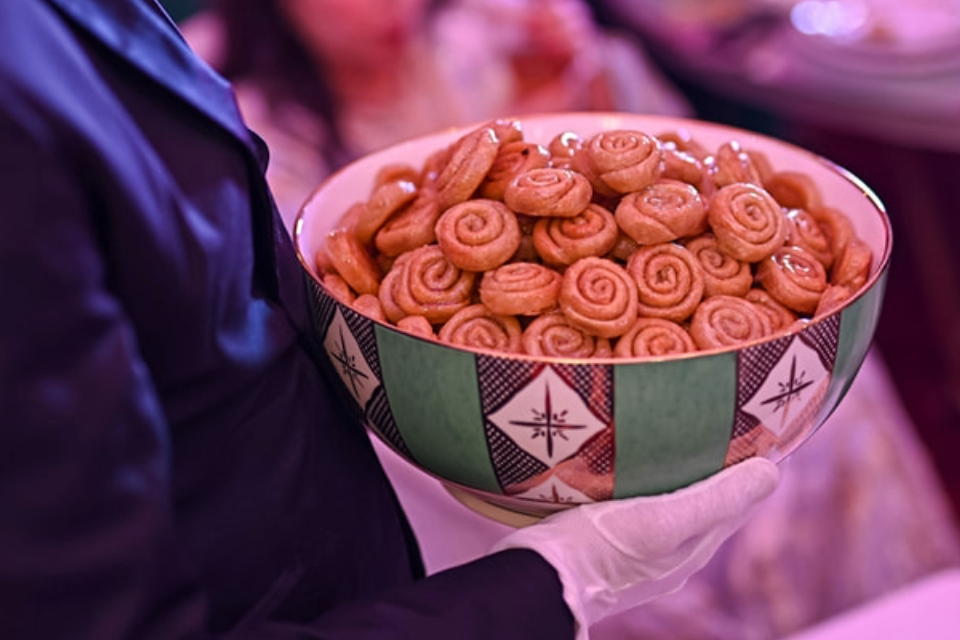
Crédit photo Afrah Darna
Wedding Presentation
Beautiful ornate silver trays display Kaab el Ghazal at our celebrations. These cookies have a special place in the midnight feast among mint tea. Each cookie gets a careful dusting of powdered sugar that creates an elegant display and symbolizes sweet new beginnings.
These delicate pastries were once exclusive to the elite because of their premium ingredients and expert preparation. Now they serve as evidence of our rich culinary heritage. Making Kaab el Ghazal brings Moroccan families together, and they guard their recipes like precious heirlooms.
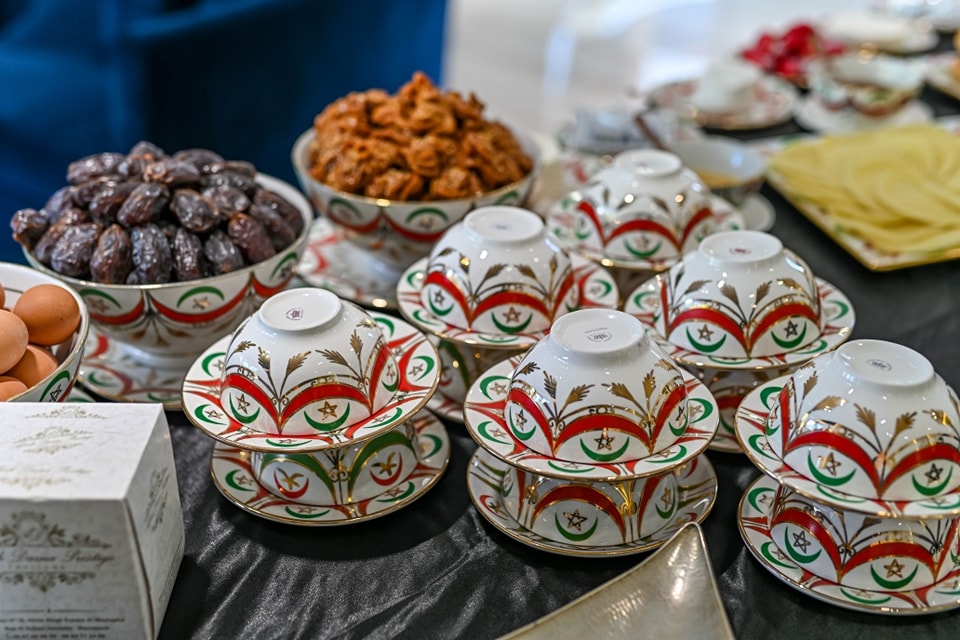
Crédit photo Afrah Darna
Moroccan Wedding Dessert Table
A spectacular dessert table marks the grand finale of our traditional Moroccan wedding feast. Sweet-making expertise passed down through generations creates an impressive display of Moroccan wedding desserts.
Essential Sweet Selections
Our dessert spread showcases traditional confections in all their glory:
- Milk pastilla with a delicate drizzle of orange blossom water
- Almond briouats create stunning geometric patterns
- Mhencha brings nostalgia to every celebration
Traditional Arrangements
Beautiful ornate silver platters display these delicacies in mesmerizing layers. Seasonal fresh fruits add natural sweetness to the offerings. The dessert table ended up as a gathering spot where guests share stories and create lasting memories.
Serving Customs
Time-honored traditions guide our dessert service. Sweet treats and stuffed dates make their way to guests throughout the day. Traditional mint tea and coffee served in decorative glasses complete the experience. This sweet finale signals the feast’s end as the newlyweds get ready to leave.
Each sweet on our dessert table tells its own unique story. Regional patterns inspire the intricate designs on our Moroccan wedding cake, and they celebrate our cultural heritage through both taste and visual appeal.
Conclusion
Moroccan wedding feasts are without doubt proof of our rich culinary heritage. Each dish narrates a unique story. The celebration starts with a welcoming mint tea ceremony and continues until the grand midnight feast.
Sweet and savory flavors blend harmoniously in these handpicked dishes. Pastilla displays its delicate layers while mechoui offers tender meat. The symbolic seven-vegetable couscous plays a vital role in wedding celebrations. These feasts deepen family’s commitment to each other and honor age-old traditions.
Each course arrives with perfect timing and elegant presentation, showing our commitment to Moroccan hospitality. Briouats enhance the main dishes throughout the evening. The dessert table’s sweet treats provide the perfect ending to these grand celebrations.
These cherished recipes and customs must live on for future generations. Our cultural heritage stays alive through the preparation and sharing of these dishes. Every wedding in Morocco becomes a beautiful celebration that honors love, family, and tradition, with the Moroccan bride and groom at the center of this culinary extravaganza.
For those considering getting married in Morocco, embracing these culinary traditions can create an unforgettable experience. From the Moroccan wedding dress to the Moroccan mens wedding clothing, every aspect of the celebration is steeped in rich cultural significance. Even Moroccan wedding guest dress often reflects the vibrant colors and patterns of traditional cuisine, creating a feast for the eyes as well as the palate.
Whether you’re planning a Moroccan dinner party or a full-scale wedding, these traditional dishes and customs offer a glimpse into the heart of Moroccan gastronomy. By incorporating these elements, you can bring the warmth and flavor of a Moroccan wedding to any celebration, creating memories that will last a lifetime.
You can explore all our wedding inspirations on our Pinterest page

